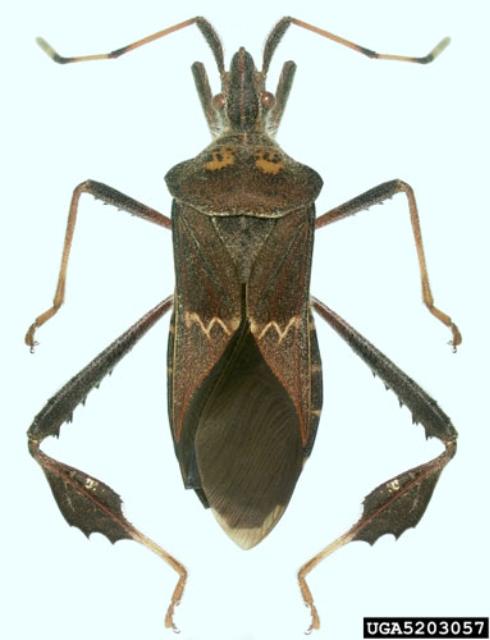| Pomegranate Pests | |
|---|---|
|
Back
to Pomegranate Page  Fig. 1 Leaf-Footed plant bug - Leptoglossus zonatus  Fig. 2  Pomegranate fruit borer - Virachola isocrates |
Minor problems are
leaf and fruit spot caused by Cercospora,
Gloeosporium
and Pestalotia
sp.; also foliar damage by whitefly, thrips, mealybugs and scale
insects; and defoliation by Euproctis
spp. and Archyophora
dentula.
Termites may infest the trunk. In India, paper or plastic bags or other
covers may be put over the fruits to protect them from borers, birds,
bats and squirrels. 1 Root knot nematode, Meloidogyne incognita, has been reported to be a serious pest. Leaf-Footed Plant Bug Leptoglossus zonatus The adult western leaffooted bugs are 19–21 mm long, dark brown, with flattened leaf-like expansions on the hind tibia. The adult is distinguished from the other Leptoglossus spp. by having a whitish zigzag band across the corium and two pale yellow spots on the anterior pronotum. L. zonatus (Dallas) is widely known as the western leaffooted bug, but this is not an approved common name. Leptoglossus zonatus is a prevalent polyphagous minor pest of various field, vegetable and fruit crops in the Gulf Coast region of the United States. It has become a key pest in citrus, especially of satsuma mandarin (Citrus unshiu Mar.). It is also considered an important emerging pest on a wide range of crops including corn, cotton, eggplant, peach, pecan, pomegranate, tomato and watermelon in the United States (Xiao and Fadamiro 2011). 2 Further Reading Leaf Borer Pest Alert, Florida Department of Agriculture and Consumer Services pdf Western Leaffooted Bug Leptoglossus zonatus, University of Florida pdf Pomegranate Fruit Borer Deudorix (Virachola) isocrates and D. epijarbas The pomegranate fruit borer or pomegranate butterfly are pests common in Asia, especially India and Sri Lanka. Adult males have glossy blue wings, females have brownish violet with an orange circular spot on the forewing. PFB larvae bore into the pomegranate fruits soon after hatching from eggs laid on flowers or young fruit. Once inside the fruit, the flat larvae (approx 2cm length) feed on the flesh and seeds. Infested fruit will often have PFB feces near the bore holes of entry. The holes ultimately expose the rest of the fruit to disease, and typically rot off the tree. 3 |
| Bibliography 1 Fruits of Warm Climates. Julia F. Morton, Miami, 1987. 2 Chi, Amelio A., and Russell F. Mizell III. "Western Leaffooted Bug Leptoglossus zonatus (Dallas) (Insecta: Hemiptera: Coreidae)." Entomology and Nematology Dept., UF/IFAS Extension, EENY-517, Original Pub. June 2012, Revised Apr. 2013, Reviewed July 2020, AskIFAS, edis.ifas.ufl.edu. Accessed 25 Apr. 2017, 8 Sept. 2021. 3 Zalom, Frank, et al. "Pomegranate Fruit Borer." Statewide IPM Program, Agriculture and Natural Resources, University of California, May 2009, ipm-pest.ucdavis.edu. Accessed 21 June 2014. Photographs Fig. 1 Wright, Natasha. "Leaf-footed bug: Leptoglossus zonatus (Dallas, 1852)." Florida Department of Agriculture and Consumer Services, 2007, Bugwood.org, bugwood.org. Accessed 20 June 2014. Fig. 2 Rohitmg. "Virachola isocrates Fabricius, 1793 – Common Guava Blue." India Biodiversity, 2014, indiabiodiversity.org. Accessed 20 June 2014. Published 21 June 2014 LR. Last update 8 Sept. 2021 LR |
|